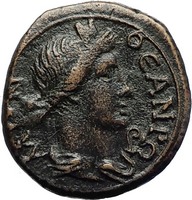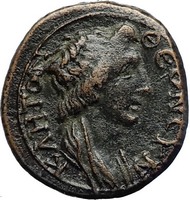Greek city of Pergamon in Mysia
Pseudo-Autonomous Issue under the Romans
Bronze 15mm (3.11 grams) Struck circa 40-60 A.D.
Reference Sear GIC 4910 var. (no lituus); RPC I 2375
ΘЄΟΝ CYNKΛHΤON - Youthful draped bust of the Roman Senate right.
ΘЄAΝ PΩMHN - Turreted and draped bust of Roma right; lituus before. Situated in the Kaikos valley, about 15 miles from the coast, Pergamon was a city of uncertain origin and of no great importance before the time of Alexander the Great. In the 3rd century B.C. it became the center of the independent kingdom ruled by the Attalid dynasty founded by Philetairos. The city was extended and beautified as the prosperity of the kingdom increased, and by the late Hellenistic times Pergamon ranked as one of the great cultural centers of the Greek world. After the end of the kingdom, 133 B.C., Pergamon became capital of the Roman province of Asia. You are bidding on the exact item pictured, provided with a Certificate of Authenticity and Lifetime Guarantee of Authenticity.
In traditional Roman religion, Roma was a female deity who personified the city of Rome and more broadly, the Roman state. Her image appears on the base of the column of Antoninus Pius. Roma, formerly queen of almost the whole earth. Horace (L. iv. od. 3) calls her the prince of cities; and according to Martial (L. xii. epig. 8) she is terrarum dea gentiumque.
Roman Senate
One of the most personifications represented emissions autonomous provincial Roman is that of the Roman Senate , widely present emissions of Lydia and Phrygia , in general, much of Asia Minor (Table 9a- c ) .
The reason may be found in the fact that the province of Asia was under the control of the Senate, but this conclusion clashes with the evidence that the Senate has never shown instead in the emissions of other provinces Senators, such as Bithynia .
Emissions autonomous province with the Senate of Rome covering virtually the whole of the period from Tiberius to Philip I, with a maximum in the period of the Antonines and the Severi .
Coinage in the iconography of imperial Rome , the Senate appears robed , with a beard as a sign of maturity , the scepter as a sign of power and sometimes with an olive branch . It is often portrayed in the presence of the imperial figure , ie the emperor shaking hands as a sign of harmony or only hope for such a harmony between the parties, as it appears on a sestertius of Commodus RIC III 549 , a similar scene is found on a sestertius of Hadrian RIC II 968, but here also appears the figure of Rome holding her hands on those imperial and Senate that huddle . On a golden age of Trajan takes on a quasi-religious while sacrificing on an altar in front of the Genius of the Roman People (RIC 374). E ' instead of a lone Caracalla Antoninianus RIC 246 and a golden Commodus RIC 157a . The inscription Genivs SENATVS confirms that the embodiment in question is precisely that of the Roman Senate .
In contrast to what was seen for the imperial emissions , the Senate of Rome autonomous provincial emissions is depicted with a portrait male youth with medium length hair type Genio Populi Romani or Bonus Eventus , sometimes the picture is instead purely feminine and l ' hairstyle becomes similar to that of Plotina , wife of Trajan, or that of Longina Domitia , wife of Domitian as it appears on the issues of mint Apollonis in Lydia (fig. 14). The legends that accompany the portrait in emissions are almost independent of the provincial type CYNKΛHTOC, ΣYNKΛHTOC, IERA CYNKΛHTOC, ΘEON CYNKΛHTON, ΣYNKΛHTON or ΘEON CYNKΛHTOY and leave no doubt on the identification. The appeal is therefore the authority of Rome through his organ very representative, who takes on a sacred (IEPA) or divine (ΘEON). As mentioned above, the period Flavio brand the passage from the use of ΘEOΣ to IEPA.
A large bronze issued to Mallus in Cilicia (BMC 30, Levante 1286) portrays the personification with head veiled in conjunction enrollment SACRED SINATVS (fig. 15). In this case, even though the Senate is in the masculine gender, the personification is typically feminine boulh in greek is in fact female and perhaps the engraver of this type did not know Latin well (considering also the obvious corruption of SENATVS in SINATVS) and has remade the genre greek. A similar issue shows instead the legend SACER SENATVS (Ovens n. 537). How to interpret the presence of this representation emission greek imperial is not easy. It is probably limited to believe that confirmation of the subjection of the Greek cities in Rome were confirmed by the presence of a call to the Senate, since over time the importance of the same was gradually decreasing, while his cult in the provinces remained almost unchanged. It should not be forgotten that the Roman Senate assumes emissions pseudo autonomous on a religious or divine, or IEPA ΘEON (the Senate is the only cult that was called both divine and sacred), and this probably has nothing to do with the control politician of the provinces. "The deification and the consecration of the Roman Senate are a product of the school of thought of the Eastern world, who wants to be surrounded by a halo and be the object of worship every manifestation of human power, as this is considered emanation of divine power" (Forni, 1954).
Pergamon was a rich and powerful ancient Greek city in Aeolis. It is located 26 kilometres (16 mi) from the modern coastline of the Aegean Sea on a promontory on the north side of the river Caicus (modern-day Bakırçay) and northwest of the modern city of Bergama. Many remains of its impressive monuments can still be seen and especially the outstanding masterpiece of the Pergamon Altar. It became the capital of the Kingdom of Pergamon during the Hellenistic period under the Attalid dynasty in 281-133 BC. Pergamon is cited in the Book of Revelation as one of the seven churches of Asia. 
AntiquityXenophon provides the earliest surviving documentary mention of Pergamon. Captured by Xenophon in 399 BC and immediately recaptured by the Persians, it was severely punished in 362 BC after a revolt. It did not become important until Lysimachus, King of Thrace, took possession in 301 BC, but soon after his lieutenant Philetaerus enlarged the town, the kingdom of Thrace collapsed and it became the capital of the new kingdom of Pergamon which Philetaerus founded in 281 BC, beginning the Attalid dynasty. In 261 BC he bequeathed his possessions to his nephew Eumenes I (263-241 BC), who increased them greatly, leaving as heir his cousin Attalus I (241-197 BC). The Attalids became some of the most loyal supporters of Rome in the Hellenistic world. Under Attalus I (241-197 BC), they allied with Rome against Philip V of Macedon, during the first and second Macedonian Wars, and again under Eumenes II (197-158 BC), against Perseus of Macedon, during the Third Macedonian War. For their support against the Seleucids, the Attalids were rewarded with all the former Seleucid domains in Asia Minor. As a consequence of its rise to power, the city expanded greatly. Until 188 BC, it had not grown significantly since its founding by Philetaerus, and covered c. 21 hectares (52 acres). After this year, a massive new city wall was constructed, 4 kilometres (2.5 mi) long and enclosing an area of approximately 90 hectares (220 acres). The Attalids ruled with intelligence and generosity. Many documents survive showing how the Attalids supported the growth of towns by sending in skilled artisans and by remitting taxes. They allowed the Greek cities in their domains to maintain nominal independence. They sent gifts to Greek cultural sites like Delphi, Delos, and Athens. They defeated the invading Celts. They remodeled the Acropolis of Pergamon after the Acropolis in Athens. When Attalus III (138-133 BC) died without an heir in 133 BC, he bequeathed the whole of Pergamon to Rome in order to prevent a civil war. RomanNot everyone in Pergamon accepted Rome's rule. Aristonicus, who claimed to be Attalus' brother as well as the son of Eumenes II, an earlier king, led a revolt among the lower classes with the help of Blossius, a famous Stoic philosopher. Aristonicus took the regal name Eumenes III. For a period he enjoyed success, defeating and killing the Roman consul P. Licinius Crassus and his army. However, his revolt was put down in 129 BC by the consul M. Perperna, and Aristonicus was executed in Rome. After this, Pergamon was divided by Perperna's successor, M'. Aquillius, among Rome, Pontus, and Cappadocia. Pergamon was briefly the capital of the Roman province of Asia, before the capital was transferred to Ephesus. After a slow decline, the city was favored by several imperial initiatives under Hadrian (117 - 138). It was granted the title of metropolis and as a result of this an ambitious building program was carried out: massive temples, a stadium, a theatre, a huge forum and an amphitheatre were constructed. In addition, at the city limits the shrine to Asclepius (the god of healing) was expanded into a lavish spa. This sanctuary grew in fame and was considered one of the most famous therapeutic and healing centers of the Roman world. Galen, after Hippocrates the most famous physician of antiquity, was born at Pergamon and received his early training at the Asclepeion. Pergamon reached the height of its greatness under Roman Imperial rule and was home to about 200,000 inhabitants. The city was an early seat of Christianity and was granted a bishopric by the 2nd century. The city suffered badly during the third century and was badly damaged by an earthquake in 262 and was sacked by the Goths shortly after. The Library of Pergamon was renowned, and second only to the Library of Alexandria, although not approaching Alexandria in scholarship.
|




